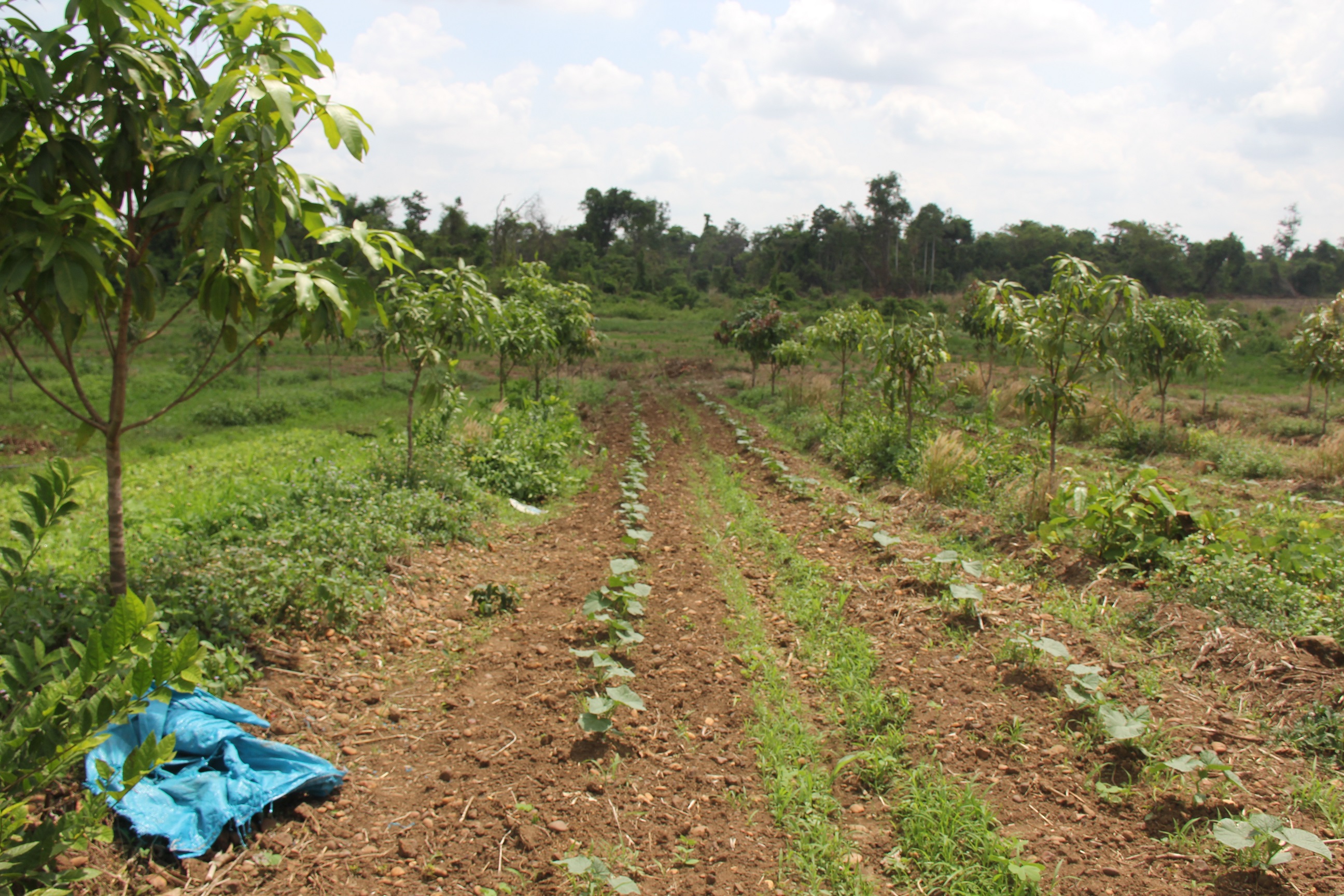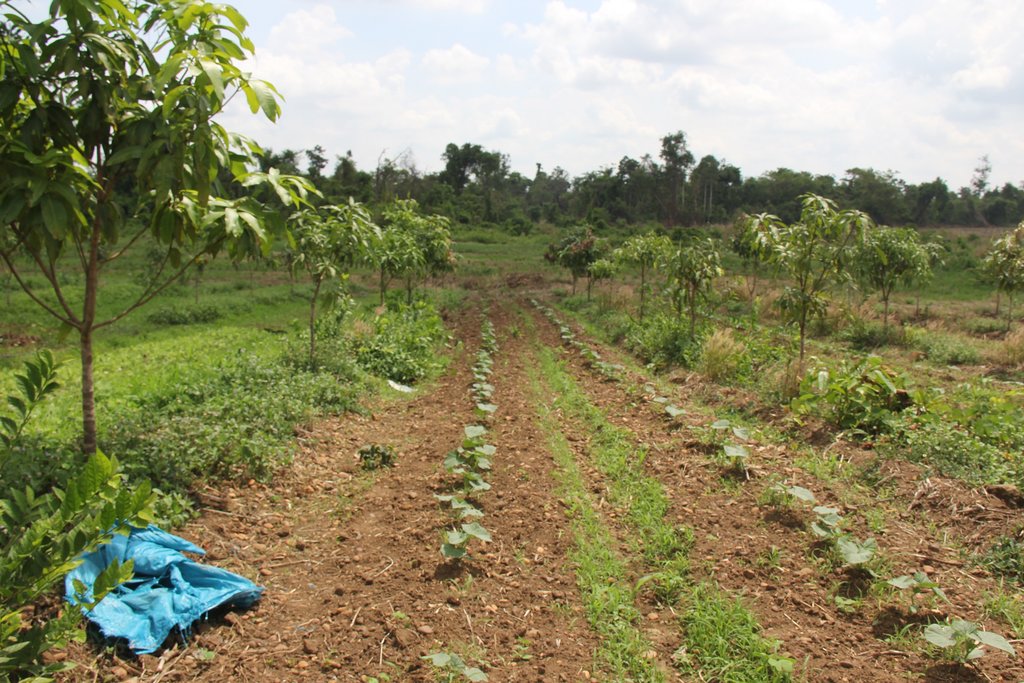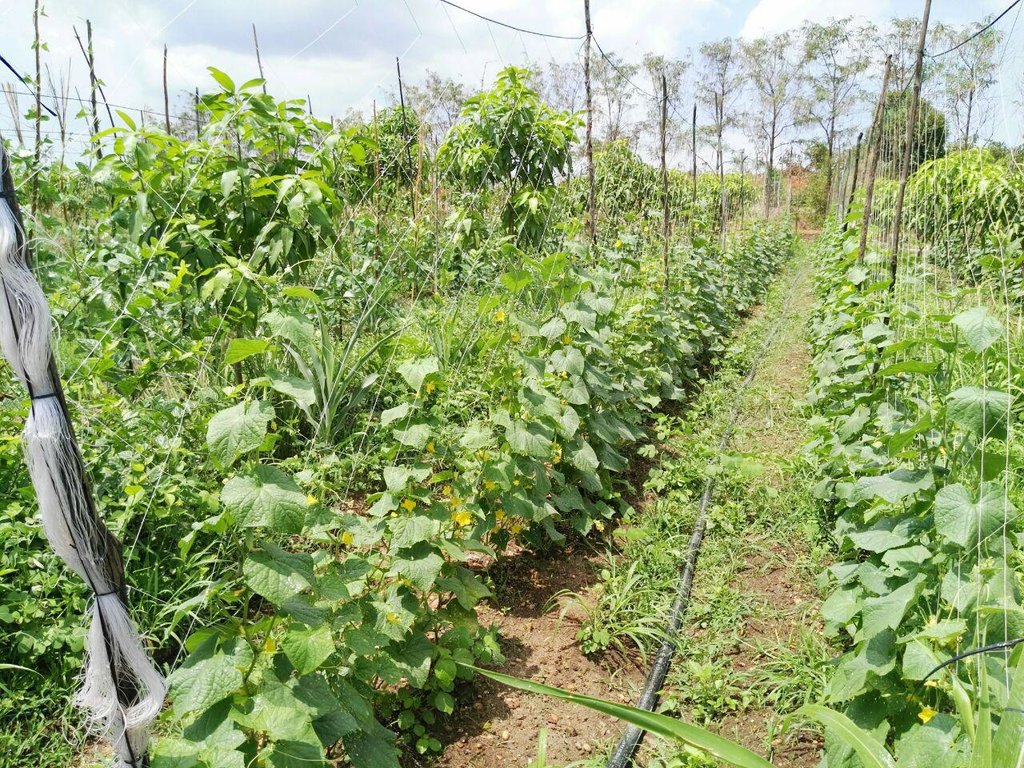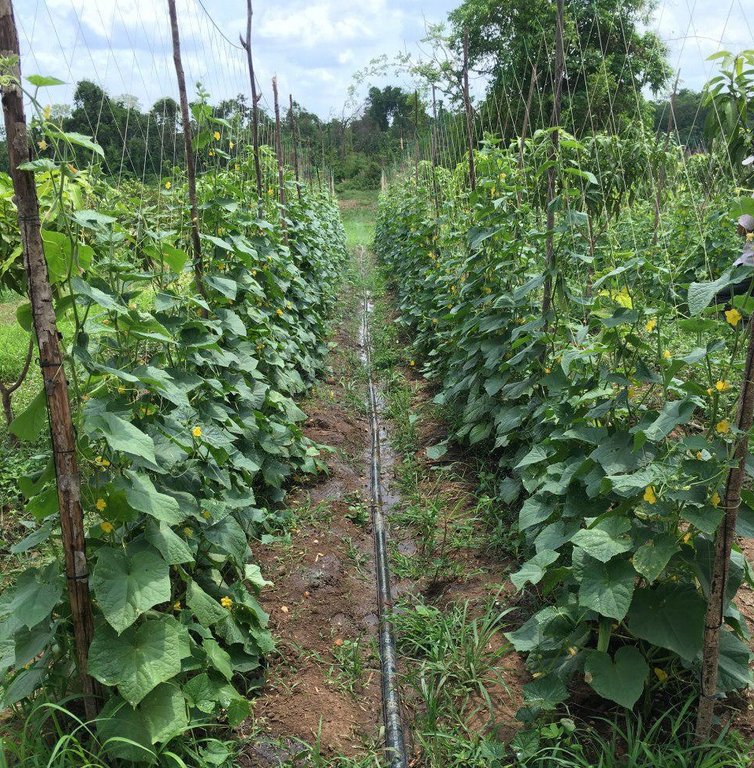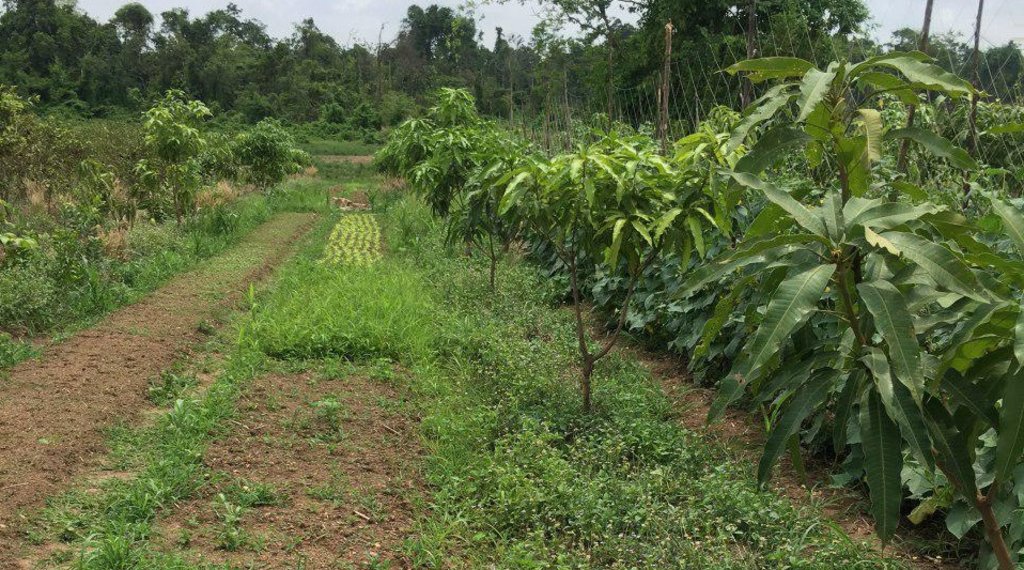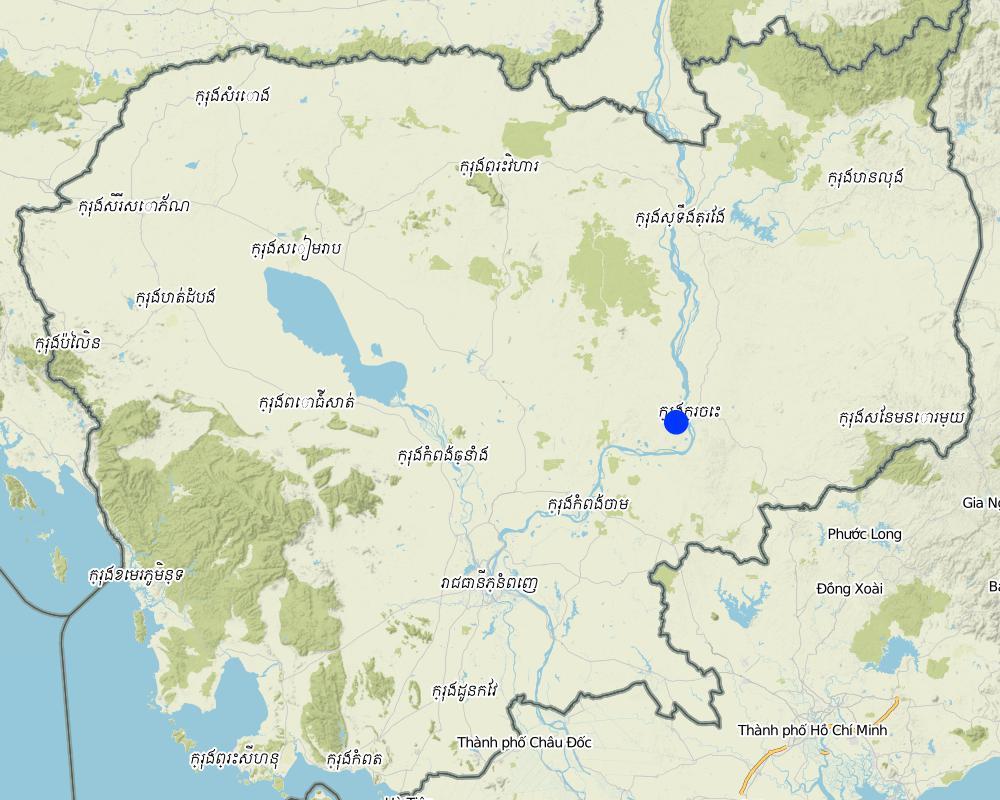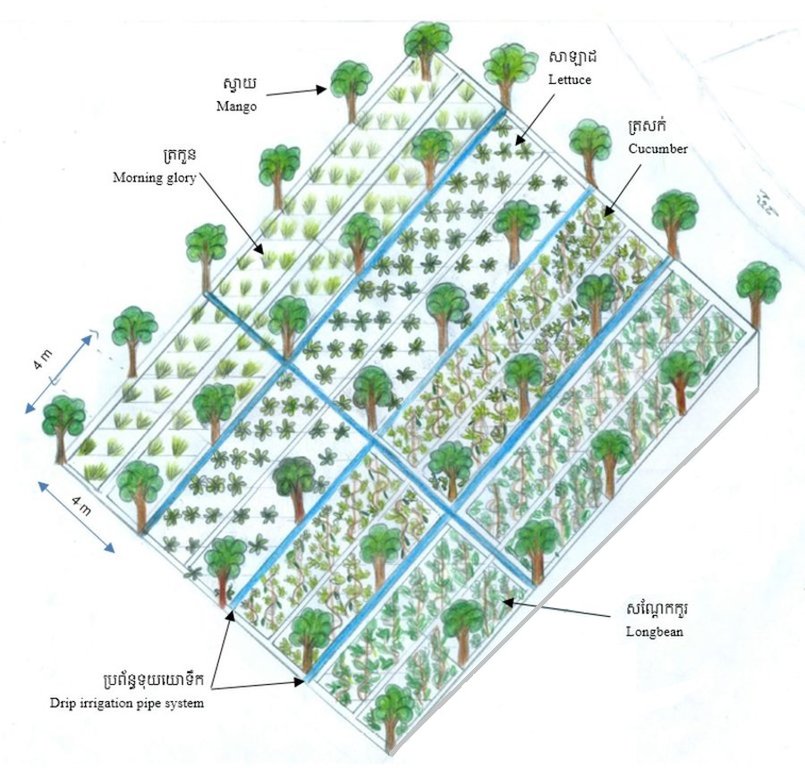Crop rotation between mango trees in combination with drip irrigation [Cambodia]
- Creation:
- Update:
- Compiler: Be Gechkim
- Editors: Navin Chea, Sophea Tim
- Reviewers: TOM SAY, SO Than, Ursula Gaemperli, Alexandra Gavilano
Organic vegetable
technologies_2236 - Cambodia
View sections
Expand all Collapse all1. General information
1.2 Contact details of resource persons and institutions involved in the assessment and documentation of the Technology
Key resource person(s)
land user:
Hour Pros
Farmer
Cambodia
Acting Chief of District Office of Agriculture, Forestry and Fisheries, Preaek Prasab:
Commune Extension Worker at Saob commune office:
Sopheak Song
Office of Saob commune, Preaek Prasab District, Kratie Province
Cambodia
Chief of District Office of Agriculture, Forestry and Fisheries, Sambo:
Official of District Office of Agriculture, Forestry and Fisheries, Chetr Borei:
Ly Saravuth
Chetr Borei district office of agriculture, forestry and fisheries
Cambodia
Name of project which facilitated the documentation/ evaluation of the Technology (if relevant)
Scaling-up SLM practices by smallholder farmers (IFAD)Name of the institution(s) which facilitated the documentation/ evaluation of the Technology (if relevant)
Royal University of Agriculture (RUA) - Cambodia1.3 Conditions regarding the use of data documented through WOCAT
The compiler and key resource person(s) accept the conditions regarding the use of data documented through WOCAT:
Yes
1.4 Declaration on sustainability of the described Technology
Is the Technology described here problematic with regard to land degradation, so that it cannot be declared a sustainable land management technology?
No
2. Description of the SLM Technology
2.1 Short description of the Technology
Definition of the Technology:
The rotational intercropping of vegetables between mango trees is a form of agroforestry. The technique aims to bear yield and income to the farmers when the trees do not bear fruit at young stage. Further purposes are the permanent soil cover which impede weed growth, reduces evaporation and soil erosion, and finally, in combination with drip irrigation it supports the adaptation to climate change.
2.2 Detailed description of the Technology
Description:
Agroforestry is the practice of cultivating cash crops and/or the rearing of livestock on a plot of land together with growing trees such as fruit trees, coco trees, bamboo or other trees so as to improve agricultural output and gain other benefits (MoE et al., 2016). Agroforestry plays a vital role in providing ecological and economic benefits which include the harvest of timber and cash crops, improved soil fertility, reduced chemical fertilizer and pesticide input, reduced cost, better adaptation to climate change (MoE et al., 2016), as well as a reduced risk of crop failure (FA and DANIDA, 2005).
Mr. Hour is one of the farmers who shifted from monoculture to agroforestry. He is living with his family at Saob Krom Village, Saob Commune, Preaek Prasab District, Kratié Province (the northeastern province of Cambodia). On a hillside plot of 2100 square meters he has 135 mango trees planted in 9 rows with a space of 4 meters between each row and each tree. A number of different cash crops are intercropped in rotation between the rows of the mango trees which include amongst others: cucumbers, morning glory, cabbages and lettuce. The mango trees are cultivated after the land has been plowed and allowed to dry for 15 days. A dimension 0.5 meter of four-size hole with 0.5 meter deep is dug for each tree into which a 2 to 3kg mixture of cow manure, husk rice and bran that has been allowed to mature for 15 days is added. The farmer makes use of a drip irrigation system which extends to each tree and runs along the rows of the cash crops. The vegetable rows are prepared according to the season, as in the dry season ridge of the rows are 10 cm and in the rainy season they are 20 cm so as to prevent the vegetables being damaged by excessive amounts of water. Moreover, this technique does not cost much and generates income when the long-term crop is not yet ready to bear fruit. Additionally there are no negative impacts on the environment because the farmer applies liquid compost and bio-extract pesticide that he has produced on his own. The liquid compost is made up of a mixture of fish residue, bran and palm sugar mixed with water, which is then allowed to mature for around 15 days before it can be used. Meanwhile, the bio-pesticide is extracted from strong-smelling and bitter trees such as strychnine plants, yellow cheesewood, neem, boraphed and galangal. The materials are chopped into small pieces and mixed with palm sugar and water, which is then allowed to settle for at least 15 days before it is ready to be applied. In order to spray the crops, a liter of the liquid pesticide should be mixed with 25 liters of water.
All in all, this form of agroforestry brings a wide range of benefits. With this system, the farmer is able to generate an income from the different cash crops which can be harvested in both dry and rainy seasons especially in the first three years of the mango tree’s life when they are still unproductive. It therefore helps to reduce the financial burden of running the whole farm. This technique also helps to regulate the local micro-climate with the shade provided by the mango trees, reduces evaporation and soil erosion, as well as adapts to drought conditions that have been brought on by climate change. Moreover, this practice avoids leaving a space between the trees that would otherwise enable the growth of unwanted weeds, which could also become a habitat for insects and the outbreak of diseases that lead to economic loss.
At first sight it may be a disadvantage that at the beginning the farmer has to raise a lot of money in order to install the drip irrigation system for example. However, once installed the system can last for many years which reduces labor costs related to irrigation. Regarding the cash crops the farmer also faces the challenge of unstable market prices. But if the prices are good and stable, the farmer is able to generate substantial income to improve the family’s livelihood. Therefore, the institutions in charge need to take into account the market forces, too.
2.3 Photos of the Technology
2.4 Videos of the Technology
Comments, short description:
N/A
Name of videographer:
N/A
2.5 Country/ region/ locations where the Technology has been applied and which are covered by this assessment
Country:
Cambodia
Region/ State/ Province:
Saob Krom Village, Saob commune, Preaek Prasab District, Kratie Province
Specify the spread of the Technology:
- evenly spread over an area
If precise area is not known, indicate approximate area covered:
- < 0.1 km2 (10 ha)
Map
×2.6 Date of implementation
Indicate year of implementation:
2015
2.7 Introduction of the Technology
Specify how the Technology was introduced:
- through projects/ external interventions
Comments (type of project, etc.):
Technical Assistance from Agriculture Services Programme for Innovation, Resilience and Extension (ASPIRE)
3. Classification of the SLM Technology
3.1 Main purpose(s) of the Technology
- improve production
- create beneficial economic impact
3.2 Current land use type(s) where the Technology is applied
Land use mixed within the same land unit:
Yes
Specify mixed land use (crops/ grazing/ trees):
- Agroforestry

Cropland
- Annual cropping
- Tree and shrub cropping
Annual cropping - Specify crops:
- fodder crops - grasses
- vegetables - leafy vegetables (salads, cabbage, spinach, other)
- legumes and pulses - other
- legumes and pulses - beans
- cucumbers
Annual cropping system:
Vegetables - wheat/barley/oat/upland rice
Tree and shrub cropping - Specify crops:
- mango, mangosteen, guava
Number of growing seasons per year:
- 1
Specify:
Long term crops with other short term crops during the time when mangos do not provide benefit.
3.3 Has land use changed due to the implementation of the Technology?
Has land use changed due to the implementation of the Technology?
- Yes (Please fill out the questions below with regard to the land use before implementation of the Technology)

Forest/ woodlands
Comments:
Before it was degraded forest land with low fertility.
3.4 Water supply
Water supply for the land on which the Technology is applied:
- mixed rainfed-irrigated
Comments:
Using water from Sre Ngeat dam near the farm.
3.5 SLM group to which the Technology belongs
- rotational systems (crop rotation, fallows, shifting cultivation)
- improved ground/ vegetation cover
- irrigation management (incl. water supply, drainage)
3.6 SLM measures comprising the Technology

agronomic measures
- A1: Vegetation/ soil cover

structural measures
- S7: Water harvesting/ supply/ irrigation equipment
3.7 Main types of land degradation addressed by the Technology

soil erosion by water
- Wt: loss of topsoil/ surface erosion

chemical soil deterioration
- Cn: fertility decline and reduced organic matter content (not caused by erosion)

biological degradation
- Bc: reduction of vegetation cover
3.8 Prevention, reduction, or restoration of land degradation
Specify the goal of the Technology with regard to land degradation:
- reduce land degradation
- restore/ rehabilitate severely degraded land
Comments:
Against seasonal water he can cultivate crops that help prevent excessive surface run off.
Before it was severely degraded forest land.
4. Technical specifications, implementation activities, inputs, and costs
4.1 Technical drawing of the Technology
Technical specifications (related to technical drawing):
This practice is applied on a plot of 2100 square meters ( width 35 meters x length 60 meters) situated on the hillside. It contains 135 mango trees (in 9 rows with the space of 4 meters between each row and tree) and a number of different cash crops grown in rotation among others: cucumber, morning glory, cabbage and lettuce. Drip irrigation system is spread to each tree and along cash row of the crops.
Author:
Ms. Kongkea So and Mr. Sophea Tim
Date:
12/04/2017
4.2 General information regarding the calculation of inputs and costs
Specify how costs and inputs were calculated:
- per Technology area
Indicate size and area unit:
2100 square meters
other/ national currency (specify):
Riel
If relevant, indicate exchange rate from USD to local currency (e.g. 1 USD = 79.9 Brazilian Real): 1 USD =:
4000.0
Indicate average wage cost of hired labour per day:
20000 Riel
4.3 Establishment activities
| Activity | Timing (season) | |
|---|---|---|
| 1. | Plow and dry the land | April |
| 2. | Mango nursery | April |
| 3. | Dig holes, prepare pipe system | April |
| 4. | Prepare biotic pesticide and fertilizer | April |
| 5. | Mango plantation | April |
| 6. | Prepare soil and ridge of the rows for vegetable | April |
4.4 Costs and inputs needed for establishment
| Specify input | Unit | Quantity | Costs per Unit | Total costs per input | % of costs borne by land users | |
|---|---|---|---|---|---|---|
| Labour | Plowing and raking | person-day | 3.0 | 20000.0 | 60000.0 | 100.0 |
| Labour | Digging the holes | person-day | 5.4 | 20000.0 | 108000.0 | 100.0 |
| Equipment | Drip irrigation system | Set | 1.0 | 800000.0 | 800000.0 | 100.0 |
| Equipment | Filter | piece | 1.0 | 120000.0 | 120000.0 | 100.0 |
| Equipment | Spade | piece | 2.0 | 15000.0 | 30000.0 | 100.0 |
| Equipment | Two-wheel tractor | piece | 1.0 | 4800000.0 | 4800000.0 | 100.0 |
| Plant material | Mango trees | trees | 135.0 | 5000.0 | 675000.0 | 100.0 |
| Fertilizers and biocides | Fish fertilizer | Liter | 200.0 | 300.0 | 60000.0 | 100.0 |
| Construction material | Net | Piece | 18.0 | 15000.0 | 270000.0 | 100.0 |
| Construction material | Bamboo trellising | Total | 1.0 | 100000.0 | 100000.0 | 100.0 |
| Total costs for establishment of the Technology | 7023000.0 | |||||
| Total costs for establishment of the Technology in USD | 1755.75 | |||||
Comments:
Regarding the cost item “Digging the holes”, the farmer indicated cost of 800 Riel for one hole (800*135 holes = 108000). In the table these costs are indicated in person-days.
4.5 Maintenance/ recurrent activities
| Activity | Timing/ frequency | |
|---|---|---|
| 1. | Vegetable nursery | April |
| 2. | Vegetable transplanting | April |
| 3. | Do the trellising | April |
| 4. | Weeding | First 10 days |
| 5. | Spray biotic pesticide | When pest existing |
| 6. | Changing pipes | When broken |
4.6 Costs and inputs needed for maintenance/ recurrent activities (per year)
| Specify input | Unit | Quantity | Costs per Unit | Total costs per input | % of costs borne by land users | |
|---|---|---|---|---|---|---|
| Labour | Prepare soil and ridge of the rows for vegetable | person-day | 3.0 | 20000.0 | 60000.0 | 100.0 |
| Labour | Vegetable transplanting | person-day | 2.0 | 20000.0 | 40000.0 | 100.0 |
| Labour | Weeding | person-day | 9.0 | 20000.0 | 180000.0 | 100.0 |
| Labour | Spray biotic pesticide | person-day | 1.0 | 20000.0 | 20000.0 | 100.0 |
| Equipment | Pipe | Piece | 3.0 | 100000.0 | 300000.0 | 100.0 |
| Plant material | Cucumber seed | pack | 4.0 | 10000.0 | 40000.0 | 100.0 |
| Plant material | Long bean | pack | 1.0 | 3500.0 | 3500.0 | 100.0 |
| Fertilizers and biocides | Bio-pesticide | liter | 20.0 | 2000.0 | 40000.0 | 100.0 |
| Other | Changing pipes | person-day | 1.0 | 20000.0 | 20000.0 | 100.0 |
| Total costs for maintenance of the Technology | 703500.0 | |||||
| Total costs for maintenance of the Technology in USD | 175.88 | |||||
If land user bore less than 100% of costs, indicate who covered the remaining costs:
N/A
Comments:
Maintenance activities for the vegetable costs are calculated only for 3 months, as it depends the on crop's life cycle.
4.7 Most important factors affecting the costs
Describe the most determinate factors affecting the costs:
The costs for the pipe system are high.
5. Natural and human environment
5.1 Climate
Annual rainfall
- < 250 mm
- 251-500 mm
- 501-750 mm
- 751-1,000 mm
- 1,001-1,500 mm
- 1,501-2,000 mm
- 2,001-3,000 mm
- 3,001-4,000 mm
- > 4,000 mm
Specify average annual rainfall (if known), in mm:
1138.20
Specifications/ comments on rainfall:
The average annual rainfall in 2015 is 1138.2 mm, in 2014 is 1696.5 mm in 2013 is 1661.8 mm.
Indicate the name of the reference meteorological station considered:
Department of Meteorology, Ministry of Water Resources and Meteorology (2015)
Agro-climatic zone
- sub-humid
There are two distinct seasons: dry season and rainy season.
5.2 Topography
Slopes on average:
- flat (0-2%)
- gentle (3-5%)
- moderate (6-10%)
- rolling (11-15%)
- hilly (16-30%)
- steep (31-60%)
- very steep (>60%)
Landforms:
- plateau/plains
- ridges
- mountain slopes
- hill slopes
- footslopes
- valley floors
Altitudinal zone:
- 0-100 m a.s.l.
- 101-500 m a.s.l.
- 501-1,000 m a.s.l.
- 1,001-1,500 m a.s.l.
- 1,501-2,000 m a.s.l.
- 2,001-2,500 m a.s.l.
- 2,501-3,000 m a.s.l.
- 3,001-4,000 m a.s.l.
- > 4,000 m a.s.l.
Indicate if the Technology is specifically applied in:
- not relevant
5.3 Soils
Soil depth on average:
- very shallow (0-20 cm)
- shallow (21-50 cm)
- moderately deep (51-80 cm)
- deep (81-120 cm)
- very deep (> 120 cm)
Soil texture (topsoil):
- coarse/ light (sandy)
Soil texture (> 20 cm below surface):
- medium (loamy, silty)
Topsoil organic matter:
- high (>3%)
If available, attach full soil description or specify the available information, e.g. soil type, soil PH/ acidity, Cation Exchange Capacity, nitrogen, salinity etc.
The soil contains a lot of gravel and sand.
5.4 Water availability and quality
Ground water table:
5-50 m
Availability of surface water:
good
Water quality (untreated):
for agricultural use only (irrigation)
Is water salinity a problem?
No
Is flooding of the area occurring?
No
Comments and further specifications on water quality and quantity:
Receive water from the nearby natural stream.
5.5 Biodiversity
Species diversity:
- low
Habitat diversity:
- low
5.6 Characteristics of land users applying the Technology
Sedentary or nomadic:
- Sedentary
Market orientation of production system:
- commercial/ market
Off-farm income:
- 10-50% of all income
Relative level of wealth:
- average
Individuals or groups:
- individual/ household
Level of mechanization:
- manual work
- mechanized/ motorized
Gender:
- men
Age of land users:
- middle-aged
5.7 Average area of land used by land users applying the Technology
- < 0.5 ha
- 0.5-1 ha
- 1-2 ha
- 2-5 ha
- 5-15 ha
- 15-50 ha
- 50-100 ha
- 100-500 ha
- 500-1,000 ha
- 1,000-10,000 ha
- > 10,000 ha
Is this considered small-, medium- or large-scale (referring to local context)?
- medium-scale
Comments:
Medium scale because he has 30 hectares and other land users have more than 50 hectares of land.
5.8 Land ownership, land use rights, and water use rights
Land ownership:
- individual, titled
- Clear degraded forest
Land use rights:
- individual
Water use rights:
- individual
5.9 Access to services and infrastructure
health:
- poor
- moderate
- good
education:
- poor
- moderate
- good
technical assistance:
- poor
- moderate
- good
employment (e.g. off-farm):
- poor
- moderate
- good
markets:
- poor
- moderate
- good
energy:
- poor
- moderate
- good
roads and transport:
- poor
- moderate
- good
drinking water and sanitation:
- poor
- moderate
- good
financial services:
- poor
- moderate
- good
6. Impacts and concluding statements
6.1 On-site impacts the Technology has shown
Socio-economic impacts
Production
crop production
Comments/ specify:
Due to the fact that he cultivates more crops than before on the same plot, the production increased. The farmer can continuously harvest because there are long-term crops and annual crops.
risk of production failure
Comments/ specify:
As long-term and short-term crops are cultivated now, the risk of failure has been reduced.
product diversity
Comments/ specify:
By thismixed system more than one crop variety is cultivated now.
production area
Comments/ specify:
The former land was degraded forest land, now he is able to cultivate it by this SLM technology.
land management
Comments/ specify:
He cultivates more crops and using only organic fertilizer and botanical pesticide that is produced by himself.
Income and costs
expenses on agricultural inputs
Comments/ specify:
Now he doesn’t have to buy chemical fertilizers anymore and he tries whenever possible to use biological pesticide produced by himself.
farm income
Comments/ specify:
He gets income now all year round, because of the compination of short-term and long-term cultivation.
diversity of income sources
Comments/ specify:
As more than one crop is cultivated on the plot, the diversity of income increased slightly.
workload
Comments/ specify:
The good soil cover by intercrops prevents the weed growing and reduces the workload for weeding.
Socio-cultural impacts
food security/ self-sufficiency
Comments/ specify:
As he cultivates more crops than before, the food security increased.
health situation
Comments/ specify:
There is less environmental pollution as he uses organic fertilizers and biological pesticides. Thus, the health situation improved.
SLM/ land degradation knowledge
Comments/ specify:
His knowledge regarding this technology has been improved due to experience and internet documents or videos.
Ecological impacts
Soil
soil moisture
Comments/ specify:
More crops cover induces less soil evaporation.
soil cover
Comments/ specify:
Due to the vegetable intercropping the soil cover improved.
soil compaction
Comments/ specify:
The roots of the mango trees are very good against soil compaction.
Biodiversity: vegetation, animals
Vegetation cover
Comments/ specify:
Due to permanent crop cover all over the year.
invasive alien species
Comments/ specify:
Invasive alien species are reduced due to crop rotation and biologial pesticide application.
beneficial species
Comments/ specify:
Beneficial species are increased because of liquid compost using.
pest/ disease control
Comments/ specify:
The own-produced bio pesticides are very effective.
6.2 Off-site impacts the Technology has shown
Specify assessment of off-site impacts (measurements):
There are no noticeable off-site impacts.
6.3 Exposure and sensitivity of the Technology to gradual climate change and climate-related extremes/ disasters (as perceived by land users)
Gradual climate change
Gradual climate change
| Season | increase or decrease | How does the Technology cope with it? | |
|---|---|---|---|
| annual temperature | increase | well | |
| seasonal temperature | wet/ rainy season | increase | well |
| seasonal temperature | dry season | increase | well |
| annual rainfall | decrease | moderately | |
| seasonal rainfall | wet/ rainy season | increase | well |
| other gradual climate change | The rain is changed because it doesn't rain until July. |
Climate-related extremes (disasters)
Meteorological disasters
| How does the Technology cope with it? | |
|---|---|
| local rainstorm | moderately |
Climatological disasters
| How does the Technology cope with it? | |
|---|---|
| heatwave | not well |
| cold wave | well |
| extreme winter conditions | moderately |
Biological disasters
| How does the Technology cope with it? | |
|---|---|
| epidemic diseases | well |
| insect/ worm infestation | well |
Other climate-related consequences
Other climate-related consequences
| How does the Technology cope with it? | |
|---|---|
| There is no problems because it has water sources and irrigation systems. |
Comments:
There is no problems because it has water sources and irrigation systems.
6.4 Cost-benefit analysis
How do the benefits compare with the establishment costs (from land users’ perspective)?
Short-term returns:
positive
Long-term returns:
positive
How do the benefits compare with the maintenance/ recurrent costs (from land users' perspective)?
Short-term returns:
positive
Long-term returns:
very positive
6.5 Adoption of the Technology
- single cases/ experimental
Of all those who have adopted the Technology, how many did so spontaneously, i.e. without receiving any material incentives/ payments?
- 91-100%
Comments:
Because not much maintenance labour is required.
6.6 Adaptation
Has the Technology been modified recently to adapt to changing conditions?
No
6.7 Strengths/ advantages/ opportunities of the Technology
| Strengths/ advantages/ opportunities in the land user’s view |
|---|
| Less labor is required due to the use of the drip irrigation system. |
| Various products which makes it easier to respond to the demands of the market. |
| Efficient use of land which does not allow grass growing. |
| Strengths/ advantages/ opportunities in the compiler’s or other key resource person’s view |
|---|
| Less labor is required because the drip irrigation system is used to water the crops and to apply fertilizer. |
| An environmentally friendly technology without any use of machines and in consequence fuel for irrigation by using ram pump. |
| A good soil management technique that enables interactive benefits among crops and trees. |
| Improves the soil's fertility as various cover crops are rotated. |
6.8 Weaknesses/ disadvantages/ risks of the Technology and ways of overcoming them
| Weaknesses/ disadvantages/ risks in the land user’s view | How can they be overcome? |
|---|---|
| Lack of financial capital. | Access funds from micro finance firms at low interest rate, or supports from project and the state. |
| Unstable market price. | Forming farmer groups and seek for support from NGOs and/or institutions in charge. |
| Cover a large expense at the beginning in order to install the drip irrigation system. | Susidies from projects, relevant NGOs and government. |
| Weaknesses/ disadvantages/ risks in the compiler’s or other key resource person’s view | How can they be overcome? |
|---|---|
| When mango trees growth up and branches spread out, he could not plant anymore these kinds of vegetable (cucumber, morning glory, etc), as they need light. | Plant other crops that do not need much light and are resistant to shade. |
7. References and links
7.1 Methods/ sources of information
- field visits, field surveys
A place
- interviews with land users
A person
- interviews with SLM specialists/ experts
4 people
When were the data compiled (in the field)?
12/04/2017
7.2 References to available publications
Title, author, year, ISBN:
Yang S. and Pean S. (2012) Organic fertilizer: Technology principle and farmer experiences. Cambodian Center for Study and Development in Agriculture: Phnom Penh. (In Khmer)
Available from where? Costs?
CEDAC and price is about 10000riel
Title, author, year, ISBN:
FA and DANIDA (2005). Guidelines for Site Selection and Tree Planting in Cambodia. Forestry Administration. Retrieved on May 15 2017 from
Available from where? Costs?
http://treeseedfa.org/guidelines_site_eng.htm
Title, author, year, ISBN:
MoE, Adaptation Fund and UNEP (2016). Agroforestry System: “Enhancing Climate Change Resilience of Rural Communities Living in Protected Areas in Cambodia”. Ministry of Environment.
Links and modules
Expand all Collapse allLinks
No links
Modules
No modules


